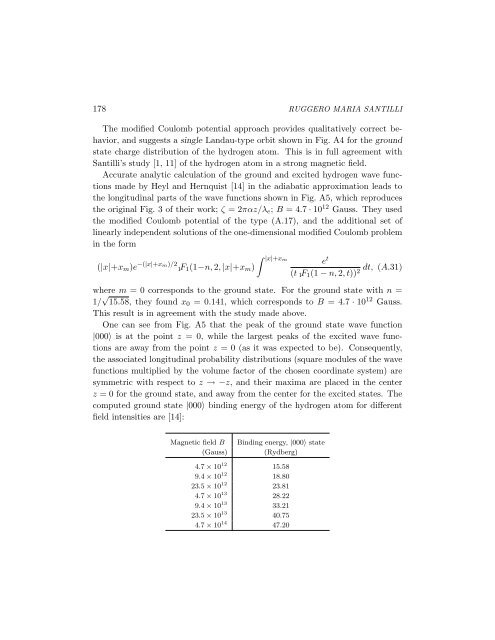the new fuels with magnecular structure - Institute for Basic Research
the new fuels with magnecular structure - Institute for Basic Research
the new fuels with magnecular structure - Institute for Basic Research
You also want an ePaper? Increase the reach of your titles
YUMPU automatically turns print PDFs into web optimized ePapers that Google loves.
178 RUGGERO MARIA SANTILLI<br />
The modified Coulomb potential approach provides qualitatively correct behavior,<br />
and suggests a single Landau-type orbit shown in Fig. A4 <strong>for</strong> <strong>the</strong> ground<br />
state charge distribution of <strong>the</strong> hydrogen atom. This is in full agreement <strong>with</strong><br />
Santilli’s study [1, 11] of <strong>the</strong> hydrogen atom in a strong magnetic field.<br />
Accurate analytic calculation of <strong>the</strong> ground and excited hydrogen wave functions<br />
made by Heyl and Hernquist [14] in <strong>the</strong> adiabatic approximation leads to<br />
<strong>the</strong> longitudinal parts of <strong>the</strong> wave functions shown in Fig. A5, which reproduces<br />
<strong>the</strong> original Fig. 3 of <strong>the</strong>ir work; ζ = 2παz/λ e ; B = 4.7 · 10 12 Gauss. They used<br />
<strong>the</strong> modified Coulomb potential of <strong>the</strong> type (A.17), and <strong>the</strong> additional set of<br />
linearly independent solutions of <strong>the</strong> one-dimensional modified Coulomb problem<br />
in <strong>the</strong> <strong>for</strong>m<br />
(|x|+x m )e −(|x|+xm)/2 1F 1 (1−n, 2, |x|+x m )<br />
∫ |x|+xm<br />
e t<br />
dt, (A.31)<br />
(t 1 F 1 (1 − n, 2, t)) 2<br />
where m = 0 corresponds to <strong>the</strong> ground state. For <strong>the</strong> ground state <strong>with</strong> n =<br />
1/ √ 15.58, <strong>the</strong>y found x 0 = 0.141, which corresponds to B = 4.7 · 10 12 Gauss.<br />
This result is in agreement <strong>with</strong> <strong>the</strong> study made above.<br />
One can see from Fig. A5 that <strong>the</strong> peak of <strong>the</strong> ground state wave function<br />
|000〉 is at <strong>the</strong> point z = 0, while <strong>the</strong> largest peaks of <strong>the</strong> excited wave functions<br />
are away from <strong>the</strong> point z = 0 (as it was expected to be). Consequently,<br />
<strong>the</strong> associated longitudinal probability distributions (square modules of <strong>the</strong> wave<br />
functions multiplied by <strong>the</strong> volume factor of <strong>the</strong> chosen coordinate system) are<br />
symmetric <strong>with</strong> respect to z → −z, and <strong>the</strong>ir maxima are placed in <strong>the</strong> center<br />
z = 0 <strong>for</strong> <strong>the</strong> ground state, and away from <strong>the</strong> center <strong>for</strong> <strong>the</strong> excited states. The<br />
computed ground state |000〉 binding energy of <strong>the</strong> hydrogen atom <strong>for</strong> different<br />
field intensities are [14]:<br />
Magnetic field B<br />
(Gauss)<br />
Binding energy, |000〉 state<br />
(Rydberg)<br />
4.7 × 10 12 15.58<br />
9.4 × 10 12 18.80<br />
23.5 × 10 12 23.81<br />
4.7 × 10 13 28.22<br />
9.4 × 10 13 33.21<br />
23.5 × 10 13 40.75<br />
4.7 × 10 14 47.20














